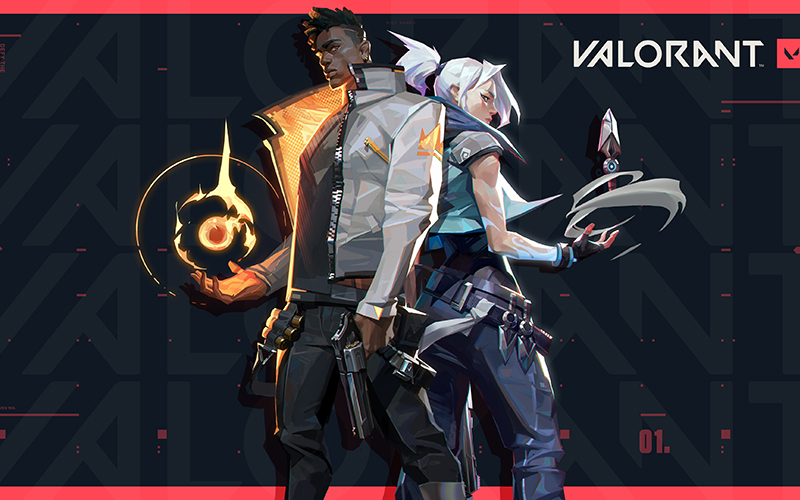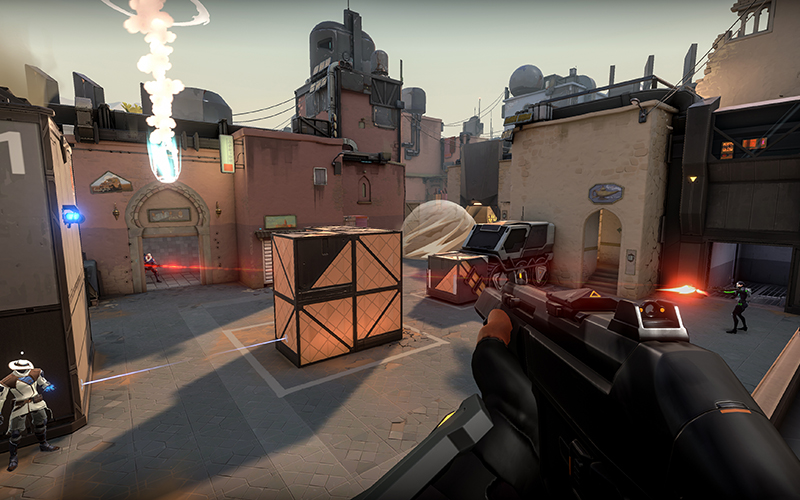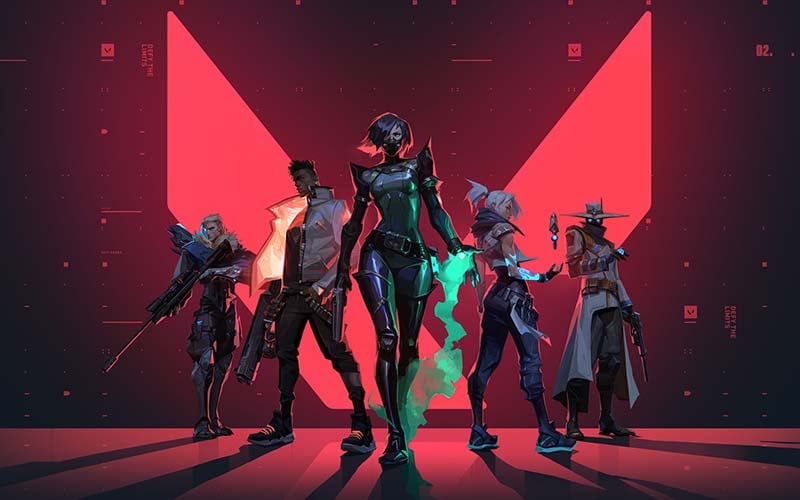
Phoenix (left) can throw flashbangs around corners to blind enemies, while Jett (right) can dash to evade gunfire. Each agent has their own unique playstyle, strengths and weaknesses. ( Image courtesy of Riot Games)

In “Valorant,” proper positioning and ability usage are key to victory. Moving to higher ground, waiting behind corners, and throwing smoke grenades are all tools players can use to approach

In “Valorant,” players only have one life per round, meaning every decision matters. Some Arizona players have praised the intensity of the game. (Image courtesy of Riot Games)

A team of five agents in Riot Games’ competitive shooter game “Valorant,” a new release that some Arizona players say could be the next big thing in esports. (Image courtesy of Riot games)
PHOENIX – Riot Games’ “Valorant” could be the next big collegiate esport in Arizona.
The free-to-play game is blend of “Counter-Strike: Global Offensive” style gameplay and objectives and “Overwatch” style abilities and player characters has drawn players from those games.
Grand Canyon University, Arizona State University and the University of Arizona are fielding teams that could build a following for the game released in early June, according to esports players and coaches.
“Valorant” has earned praise from some notable figures in the Arizona esports scene.
The game is similar to its contemporaries and has its downsides, such as privacy concerns. But it has been applauded for its deep gameplay –it’s free to play but requires highly skilled players. Arizona schools are getting ready to field teams for the season, which will heighten rivalries and raise the level of competition. Arizona esports figures hope that if the game gets updates and fixes problems, the game will be a huge success.
“Valorant” is the first major game Riot has released since “League of Legends” came out in 2009, and it blends “Counter-Strike’s” competitive shooting and objectives with the hero abilities and skills of a class-based shooter like “Overwatch.”
Valve’s “Counter-Strike” franchise is synonymous with esports. The competitive shooter’s precise gameplay, high skill barrier, and simple yet compelling objectives have made each entry in the long-running series a hit with esports players, fans, and gamers in general. The most recent in the series, the 2012 release “Counter-Strike: Global Offensive,” has more than 800,000 players at any given moment. Riot’s first game, “League of Legends” has an impact that led to the winning team of the 2018 world championship netting more than $2.4 million in prize money.
‘Valorant’, some say, combines the best of esports first-person shooter games with Riot’s experience in competitive game design.
Yoda gets 3 and @asuesports is keeping it close on Offense vs @UCIEsports Map 1 of @GiantSlayerVAL Collegiate Arena: https://t.co/TFZKqIU21u pic.twitter.com/q03ww2Nrr1
— Jake Neerland (@FarwaterGG) June 9, 2020
Exciting but still on trial
“It’s really fun to see a game like CS: GO,” GCU Valorant player Justin “FilthyFoss” Foss said, “but that ability usage like Overwatch but with a higher skill ceiling. It’s awesome, I love it. And that game is turning out so good.”
Foss previously played on GCU’s “Overwatch” team but grew bored and decided to switch to “Valorant.”
“When I saw Valorant, that it was an FPS (first-person shooter) that had abilities,” Foss said, “It was like CS:GO and Overwatch combined. I was like, ‘Okay I love shooters. I love FPS.’ And I’m looking for that FPS drive that Overwatch doesn’t give me any more.”
Foss is a big fan, but while some are certainly going to try “Valorant” out, they’re less hesitant to crown the game yet.
“We got a large CS: GO and Overwatch community, especially competitive. We got two teams for both, and Valorant drew in a lot of those people for at least trying the game,” University of Arizona “Valorant” division head Jacob Waitt said.
How the game works
“Valorant” shares much more in common with “Counter-Strike: Global Offensive” than it does “Overwatch.”
“Valorant” is a five versus five competitive first-person shooter with multiple rounds in one match and an economy where players are given currency throughout the game to buy weapons, armor, and abilities at the beginning of each round.

In “Valorant,” players only have one life per round, meaning every decision matters. Some Arizona players have praised the intensity of the game. (Image courtesy of Riot Games)
https://twitter.com/GiantSlayerVAL/status/1270167531706290177?s=20
Players only get one life per round of “Valorant” which makes each encounter tense and significant. The spike, which is essentially a bomb, is an important aspect of each round. The round will end no matter how many players are left if the spike explodes or if it is defused by the defenders.
“The thing that makes Valorant different from other games is that like this is that there’s abilities. So some characters have flash bangs, some characters can resurrect, just various things like that,” Patrick said.
Jett, one of the game’s 11 agents, can dash in any direction at high speeds, allowing her to evade enemies. Agent Phoenix has a flashbang that curves around walls and corners, letting him temporarily blind an enemy from behind cover.

Phoenix (left) can throw flashbangs around corners to blind enemies, while Jett (right)can dash to evade gunfire. Each agent has their own unique playstyle, strengths, and weaknesses. (Image courtesy of Riot Games)
Each agent has a powerful ultimate ability that builds up over the course of the game. Sage’s ultimate lets her revive one dead teammate and Raze’s ultimate briefly gives her a deadly rocket launcher. These abilities can only be used a few times during a match but make a big difference in battle.
“Valorant” has many of the unique gameplay quirks that have made “Counter-Strike” so popular over the years, such as spray patterns on the player’s weapon, walking slowly to hide the sound of footsteps, map callouts, and standing still during a fight to shoot more accurately.
Low cost-barrier to entry
Not only is “Valorant” free, it doesn’t require a high-end PC to play the game. That’s good news for most college students.
“Any time you have low specs it just reduces the barrier to entry which will always increase the amount of people who play,” Patrick said. “It also makes it really easy for people who only play ‘League,’ as they set it up for people who only play ‘League’ to play ‘Valorant’ on the exact same PC, and because of that, they are going to attract more college students.”
GCU also has a dedicated esports arena on campus. Those who might not have a PC of their own can pay a small fee ($4 for a few hours of play, Foss says) to use one of the many computers to play competitive games.
“We have 72 high end PCs that are open use, you have to pay but they’re super cheap,” Patrick said. “If you’re on a JV or varsity team, you get unlimited practice hours.”
It also provides an opportunity for gamers who are used to console gaming.
“A lot of people come from console, and that’s fine, you know, console is great,” Foss said. “But for stepping it up to the PC level and learning that, I think GCU has a great program.”
Construction of collegiate competition
GCU uses a tiered system for arranging esports teams. The varsity team consists of the best high-level players in the school who occupy the highest rank in the game’s ranked competitive mode. The JV team has players of average skill level of lower ranks.
The academy team has no ranking requirements, and is mostly for players who want to play competitive matches for fun with a consistent group without spending time practicing or competing in tournaments.
“My job is to help organize our team. I’m in charge of getting our team put together,” Patrick said. “We’re probably going to have three teams this coming semester because people are really into Valorant.”
Patrick will also be looking to organize events and tournaments to drive player interest and get more people into the game.
“We want to do five versus five tournaments and maybe three versus three tournaments just for the fun of it,” Patrick said. “My job is also to facilitate the community of Valorant.”
Arizona is forming a team as well, and ASU’s team has already been competing in collegiate tournaments.
“I’m the captain of the temp team we’re running to do tournaments as they’re popping up, and hopefully I’ll be the coordinator of the game for the U of A club,” Waitt said. “I’ll be running the team, running all the tryouts for the team. I’ve been working with the admins at the club to try to get stuff on Valorant going.”
Waitt said that it’s been somewhat hard to coordinate a team due to COVID-19 closing down schools and summer break separating students, but he mentioned he planned on doing tryouts in the Fall.
Floss said that it’s easy to maintain interest, but organizing competitive teams is a bit difficult when the campus is not open.
Regardless, interest in “Valorant” had grown quickly at Arizona schools from its March 2 reveal to its April-May beta test and June 2 release.
“Every little new clip, every little new thing, we would be talking about it and saying ‘oh, this game looks so cool,’ and then beta keys started dropping,” Foss said.

In “Valorant,” proper positioning and ability usage are key to victory. Moving to higher ground, waiting behind corners, and throwing smoke grenades are all tools players can use to approach.
Once the ranked mode arrived in the beta, GCU students started making teams with each other and that momentum carried over onto the game’s release. Even those who were not skilled or particularly good at the game were interested in playing.
“For me, I love the whole community aspect,” Foss said. “I’m always trying to bring all the different games together trying to figure out a way for everyone having a good time. So having a game where everyone wants to play it, even if they aren’t good and just want to play, makes me really happy and excited.”
Duels in the desert
For “Valorant” in Arizona, rivalries can provide entertainment value for spectators and players. Between ASU, Arizona, and GCU, rivalries in “Valorant” are developing quickly, stemming from a previous, friendly beef in “CS: GO” or “Overwatch”.
“There’s already a lot of trash talk, I can tell you that,” Patrick said before mentioning a mid-June competition: “We’re currently in a tournament with ASU and sadly ASU got knocked out, which was disappointing as we were looking forward to potentially playing them.
Patrick said that playing against ASU gives the GCU team extra motivation to win.
“When we’re playing other schools, we don’t have much of an opinion,” Patrick said. “But whenever it’s ASU, everyone in the esports arena gets a little riled up. It’s like, all right, time to crush ASU.”
For Waitt, getting familiar with your opponents from other schools makes it even more fun for him and his Arizona teammates.
His experience in past games has gotten him acquainted with some of his potential Valorant opponents.
“To actually know the players made playing them a lot more fun in a competitive environment,” Waitt said. “I hope the same will reach out into Valorant, and I’ll do my best to personally meet up with them and see if we can get something going and try to get these rivalries started. Because if my experience in Overwatch will be any bit similar, it’s just really fun to play against Arizona schools in these rivalry settings.”
Local tournaments and multiple-school events will also help develop the rivalries of the game in Arizona. And maybe it will help “Valorant” become an esports staple of the state.
“They’re gonna be fun rivalries to keep going,” Foss said. “Hopefully some of the Overwatch players will come over, that way I can see some familiar faces and smack down on them.”
Fun but flawed
“Valorant” is far from perfect. Some players complain about its core design and some raise problems with issues like privacy.
The game’s anti-cheating software, which is a required download in order to play, is active even when you’re not playing.
In computer games, anti-cheating software typically only monitors someone’s computer when they are playing the game. However, “Valorant’s” anti-cheat program checks players’ computers even when they’re not playing. Some on the internet believed the program was too intrusive, especially as it seemed the anti-cheat would block or disable random applications unrelated to cheating.
Also, some players are reporting issues with game performance – (how well the game runs) – and inconsistent hit registration after a patch adding the ranked mode to the game was released on June 24. This is not the first time players have found bugs with the game – a paid cosmetic skin for one of the game’s sniper rifles gave players an unfair advantage back in April during the game’s beta, which has since been fixed.
Players were also complaining about “leavers” – people who join games and leave before they’re finished– which ruins matches. That lead to Riot increasing punishments for those who leave games early and adding a surrender option to forfeit the game. Riot also added a money boost for the team who had a player disconnect as well as an ultimate ability point, but fans have debated replacing a disconnected player with an AI player that can be controlled by a dead teammate, a feature present in “Valorant’s” contemporary, “Counter-Strike.”
Patrick mentions that more hardcore “Counter-Strike” players will dislike the lower skill barrier and depth of “Valorant” and will still be playing their game.
“In the Arizona sense, the game will continue to grow and get bigger. At the collegiate level, CS:GO players are going to hate it but Overwatch players will migrate,” Patrick said.
Patrick said he has faith that “Valorant” will routinely be supported and updated and also mentioned that Riot is paying attention to the collegiate scene for the game.
While Waitt said he is open to new content, he hopes Riot introduces new characters and maps at a more steady pace to prevent the game from becoming oversaturated with too much content.
“The benefit of adding characters is that it’s new content, which increases the longevity of the game and player enjoyment, but the issue with adding too many characters and adding them too quickly is that these characters can define how the game is played and change the point of focus of the game,” Waitt said.
Despite the games’ issues, Waitt hopes Valorant succeeds.
“In five years, I hope the game has a full esports scene, I hope to see Valorant going neck and neck with Counter-Strike,” Waitt said. “I hope to see things only grow from here in Arizona.”
